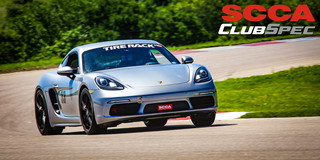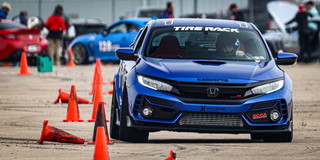
This article first appeared in the July, 2016 edition of SportsCar Magazine. SCCA members can read the current and past editions of SportCar digitally here after logging into their account; To become an SCCA member and get SportsCar mailed to your home address monthly in addition to the digital editions, click here.
“Easy over that crest!” I shouted from the passenger seat of a brand-new Porsche GT3, as we sailed into Schwedenkreuz at the Nürburgring. Zero response from my lead-foot client, driving like he was still in the Mini track car he was used to. It had been in one ear and out the other ever since we hit the track. Every time he went out on his own, I was genuinely surprised when he returned in one piece.
As the Porsche got light over the blind decreasing radius crest, the rear-mounted engine began another of its famous treks to the front, and some too-little, too-late steering correction caused a monster hook-slide that shot us off driver’s right, caroming off the Armco with a frightening “prannnnng”. As we crawled from the wreckage, both of us seemed OK, and an official vehicle pulled up, disgorging a couple uniformed attendants with notepads. Ambulance? Not yet. Tow truck? It is still on the way. First on the scene? The damage assessors.
Right on the spot, damage was calculated and the car owner swiped a credit card, even as the smoke was still wafting from the scene. For the car? Already? Some Porsche finance commandos? Not this time, driving enthusiasts. These nattily attired representatives were delivering an on-the-spot invoice for the guardrail! So, even before moving his crumpled, barely broken-in 911, my client paid a sizeable bill to rebuild the wall.
This was the first I’d heard of this disturbing new trend. Becoming ever more common in the U.S., this is a complete switch from the days of old, when tire walls and barriers were always the sole responsibility of the track itself. After all, if you drive fast, at some point, you are very likely to go off and hit something. It’s part of the adventure, and it’s way better than even further into the past, when races were held on the open roads.
I have been so pleased to see the many new tracks that have sprung up over the last 20 years, and I am all for helping them keep pit lane open. However, something about charging racers for damage to track safety barriers gets under my skin. Maybe because for the vast majority of my career, the tracks handled that, paid for by our rentals and entry fees. What changed?
A few years back, as I rolled over the track-crossing bridge into VIRginia International Raceway for another great weekend pursuing my passion, I glanced left as I always do, to soak in the stunning view of the awe-inspiring Climbing Esses in the early morning mist. To my horror, I saw foundations and walls going up. Right next to this Category 5, 140mph, demon challenge of a leaping zig, known to bring whimpers from even the most hardened competitors when things go awry.
As I’ve mentioned here before, I wrote a quixotic letter to the track management, insisting that they move those new condo/garages back a good 50 yards, just to get it on paper. After a polite response from the track manager, construction was completed as is, and many a fine machine has met its demise on the back porches of these lovely luxury digs. In fact, my future former girlfriend was one of the first, spinning in someone else’s spilled coolant and backing a nice Cayman into the brand-new tire wall that used to be a hundred yards of open grass. Ever the gentleman, I subsequently offered my car, and something wonderful and too short grew from it. So, there’s that.
My point? If racetracks are going to start charging racers for crash damage, then is it not reasonable for racers to now be entitled to charge the tracks for damage to their cars? Maybe if your walls were not so close, the cars would not hit them – or at least, maybe not so hard. Maybe if your runoff areas were better smoothed, then cars would not be launched into dramatic and destructive rollovers?
I’m not sure if my beloved Sebring has yet joined this trend, but as I watched a Porsche Cup race this spring from the exit of Turn 1, there was a spin. The driver failed to go both feet in, and rolled back across the track into traffic. One of my clients, a very talented young man, swerved deftly to the grassy verge, successfully avoiding the melee that ensued, completely unharmed. Next thing you know, the car was thrown three feet into the air, landing heavily on its nose, breaking radiators and, in fact, bending the chassis! An old crossroad languished in that green runoff, acting as a stunt ramp that would have made The Fast and the Furious proud.
Who can forget Joey Hand’s wild nose-to-tail tumbling ride in a GT BMW at Mid-Ohio, due to a similar circumstance, a track connector and a drainage swale in the runoff shoulder along the back straight?
Look, I adore my racetracks and relish the opportunity to push machines to their sublime limits, but what changed? Haven’t safety walls and guardrails always been part of being a racetrack, since hay bales and buried tires, and a normal part of running the place? Isn’t crashing now – and always – a normal part of racing?
On the other hand, I have long prided myself on doing very little damage to guardrails, so maybe I’m better off if the poor schmucks who are lying in the hospital bed after a big hit are delivered a $3,500 bill with their pain pills, rather than for my team and sanctioning body to have to pay higher entry fees? Maybe the consideration of this liability will make drivers a little more careful – at least the second time?
I’ll tell you this, my friends, if I write a check to a racetrack for three $1,000 pieces of guardrail, roughly the going rate, I want to be darned sure those new rails go in, too. Otherwise, it’s a gouging of the track junkie racers for which these facilities exist.
I say this new revenue source for tracks opens a new door that may swing both ways, and don’t be surprised if racers start challenging right back for damage that could have been avoided with better design and maintenance.
Words by Randy Pobst
Image by Dave Green










